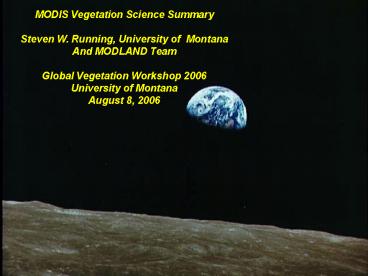MODIS Vegetation Science Summary - PowerPoint PPT Presentation
1 / 35
Title: MODIS Vegetation Science Summary
1
MODIS Vegetation Science Summary Steven W.
Running, University of Montana And MODLAND
Team Global Vegetation Workshop 2006 University
of Montana August 8, 2006
2
MODIS BRDF/Albedo Products
- Combined Terra and Aqua MODIS surface
reflectances are used to retrieve highest quality
products - Product provider measures of surface albedo and
anisotropy - Intrinsic surface albedos
- BRDF models
- Nadir BRDF-Adjusted Reflectances (NBAR)
- V005 reprocessed products provided at three
resolutions - 500m (for mesoscale applications)
- 1km (for regional applications)
- 0.05deg (for global applications)
- 500m products provide better spatial detail and
will allow global land cover at 500m spatial
resolution
3
MODIS BRDF/Albedo Products
Version 5 White Sky Albedo products in New
England area with 3 different resolutions (500m,
1km, and 0.05 degrees)
4
MODIS Fire Albedo Product Application
ExampleJin, Y.1 and Roy, D.P.2 Fire-induced
albedo change and its radiative forcing at the
surface in northern AustraliaGeophys. Res.
Lett., 2005, 32, L13401, doi10.1029/2005GL022822
1 Department of Earth System Science,
University of California, Irvine, CA2
Geographic Information Science Center of
Excellence, South Dakota State University,
Brookings, SD
5
Global, annual-mean radiative forcings (Wm-2)
due to a number of agents for the period
pre-industrial (1750) to present,
Intergovernmental Panel on Climate Change 2001
6
Shortwave instantaneous D albedo due to fire
Sienna - Blue -
Green - Yellow -
Red gt0.0 0.0 to -0.02
-0.02 to -0.04 -0.04 to -0.06
lt-0.06
Increase Decrease
7
Instantaneous radiative forcing (Wm-2)
Sienna - Blue -
Green - Yellow -
Red lt0.0 0.0 to 5.0
5.0 to 10.0 10.0 to 15.0
gt15
Cooling Warming
8
Mapping Wildfire Effects For Rehabilitation and
Inventory Applications
From Rob Sohlberg, Univ of Maryland
9
Vegetative Cover Conversion Change Due to
Burning (VCC-CDB)
Montana
Idaho
The Vegetative Cover Conversion product (VCC) is
designed to be a global alarm product for rapid
land cover change. VCC intends to locate change
caused by deforestation, fire, and floods.
VCC-Change Due to Burning (VCC-CDB) is generated
at 250m resolution using data from the MODIS
instrument and the Normalized Burn Ratio (NBR)
calculated from 16-day composites.
10
Vegetative Cover Conversion Change Due to
Burning (VCC-CDB) Validation
High Low
USFS BAER polygon
Figure 1a - USFS BAER Mineral Primm fire polygons.
Figure 2a - MODIS VCC-CDB fire intensity (yellow
low while red high), with USFS BAER Mineral
Primm fire polygons.
Figure 3a - Aggregated MODIS VCC-CDB polygon.
Area in red represents VCC-CDB within the BAER
polygon while the area in dark green is outside
the BAER Mineral Primm fire polygon.
11
Summer 2003
12
Mildrexler et al 2006
13
(No Transcript)
14
(No Transcript)
15
(No Transcript)
16
(No Transcript)
17
(No Transcript)
18
Large Seasonal Swings in Leaf Area of Amazon
Rainforests
0.0 0.3 0.8 1.6 2.8 4.2 5.0 7.0
Annual Average Leaf Area Index
Myneni et al. PNAS (in press)
19
Spatially Averaged Behavior LAI Amplitude
Leaf area data of the Amazon rainforests exhibit
notable seasonality, with an amplitude (peak to
trough difference) that is about 25 of the
average annual LAI of 4.7, over the entire course
of the data record.
20
Spatially Explicit Behavior Pattern
The derived spatial pattern of seasonal LAI
amplitude reveals a heretofore unknown picture of
phenology over a broad contiguous swath of land,
anchored to the Amazon river, from its mouth in
the east to its western-most reaches in Peru, in
the heart of the basin.
21
MOD12Q2 Global Vegetation Phenology
From Mark Friedl, Boston Univ.
- First global products for vegetation phenology
based on MODIS EVI data released for 2001-2004 - Identifies key transition
- dates in growing season
Onset EVI maximum
Onset EVI increase
Onset EVI minimum
Onset EVI decrease
22
Footprint of Urban Climateson Phenology
- Results
- Phenological signature extends well beyond urban
periphery - Exponential decay
- Footprint
- 2.4 x urban area
- Longer growing season
23
Precipitation-Driven Phenology in Africa
- Compare Onset of rainy season (TRMM) onset of
greenup (MODIS) - Linear model explains 93-95 of variance in
timing of greenup onset
greenup
dormancy
24
Jolly, Nemani, Running. Global Change Biology
2005
25
Seasonal Growing Season Constraints
Russia, Boreal
Africa, Savannah
- Jolly, Nemani, Running. Global Change Biology 2005
26
US West Montane zone vegetation dynamics change
in response to a global warming-like temperature
increase induced by a severe drought Plants
green up and ecosystem becomes vulnerable to
invasive species
- Kamel Didan, Alfredo Huete
- TBRS Lab., SWES Dept.
- The University of Arizona
AGU Fall Meeting, 2005 San Francisco, CA
27
Cumulative VI anomaly
Start elevation 2700m
2002
Peak elevation 3300m Mixed conifers-Sub-Alpine
2005
28
Cumulative VI anomaly (the Rockies)
2002
2005
29
Summer 2003 fPAR 'anomaly acc. to MOD15
FPAR 'anomalyJul./Aug./Sept. 2003-mean(2000-2002
) Unit fraction
Reichstein 2005
30
Summer 2003 GPP 'anomaly acc. to MOD17
GPP 'anomalyJul./Aug./Sept. 2003-mean(2000-2002)
Unit kg m-2
Reichstein 2005
31
TEST OF NEW MODIS DAILY EVAPOTRANSPIRATION
Cleugh et al 2006
32
Developing an Integrated MODIS-SeaWinds Phenology
Measure
Map (a) of the statistical correspondence (r2)
between growing season 8-day composite MODIS LAI
(MOD15A2) and SeaWinds Ku band backscatter for
January 2000 through August 2002 for North
America. The MODIS land cover product is also
shown (b). Temporal variability in the SeaWinds
Ku-band backscatter signal corresponds closely
with seasonal variations in MODIS derived LAI for
grassland and broadleaf deciduous forest biomes
of North America. The combined information from
MODIS and SeaWinds may provide an improved
measure of vegetation phenology that is less
constrained by atmospheric aerosol contamination
(e.g., clouds, smoke) and solar illumination
effects.
Source Frolking, S., T. Milliman, K.C. McDonald,
J. Kimball, M. Zhao, and M. Fahnestock, 2006. J.
Geophys. Res. (In press)
33
JUNE 2004 MONTHLY NPP ANOMALY
34
The increase in NPP is very modest compared to
population growth
- ? NPP per capita ? NPP / ? Population
Milesi et al 2005
Over 80 of the populated land areas NPP per
capita declined
35
TOPS Overview
Nemani et al 2005































